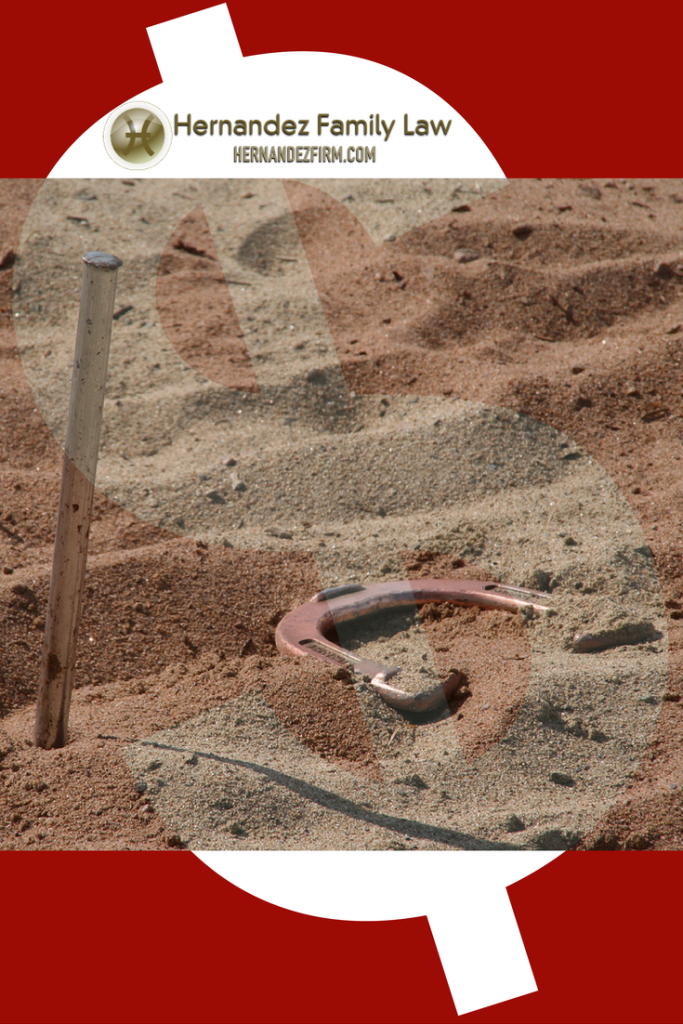Division of Community Property: Divorce Shares Something With Horseshoes
Written by: Stefano Ceroni
When it comes to the division of community property (property that is accumulated during your marriage), a lot will hinge on whether you live in (1) an Equitable Distribution State or (2) a Community Property State.
In the United States today, only nine (9) states, including the State of Arizona, are considered to be Community Property States. This is significant to understand because although you may have accumulated property during your marriage in a non-community property state, an Arizona State court will apply its own law principles to the division of your community property. A.R.S § 25-318.
So, now that we all know what kind of State Arizona is: what does it actually mean to be a Community Property State?
Well, when I ask if my clients know the answer to this question, I find the most common response to be something along the lines that “community property means we divide everything equally; 50/50, right?”
Close, but not quite!
The truth is, although the theory of community property has greatly simplified the procedure for dividing up marital property, the 50/50 summation given by many of my clients is by no means a complete explanation of the law. In fact, in the State of Arizona, the community property law principles are not too unlike those used in many Equitable Distribution States. The reason being, Arizona law does not specifically say that all “community property” (defined in A.R.S .§ 25-211) be divided equally. Instead, Arizona’s law specifically states a court must divide community property equitably, though not necessarily in kind, and without regard to marital misconduct. Over time, this difference in language has proved to be quite significant.
Because the Arizona legislature freely chose to use the word equitable as opposed to equal, the Arizona courts have interpreted the statute as allowing them discretion to consider principles of fairness when determining how to divide community property. As a result, there is not a specific mandate in Arizona that community property be divided exactly 50/50.
Now, in practice, it is the general tendency of Arizona courts to divide and allocate community property assets and debts as close to equally as possible. In fact, when a clean division of property and debts is not possible, the Court will almost always order the party receiving the beneficial share to pay the other party equalization in order to make up for the unequal distribution.
For example, let’s say that a divorcing couple has no substantial assets (i.e. home, cars, bank accounts, retirements, etc.) but they have two (2) credit cards with substantial debt. Let’s also say that both credit cards are made up 100% of community debt. Now, if each card is in each individual’s separate name, it would make most sense for each party to simply take the debt in their own name and retain ownership of that card. This way, there is no issue regarding the future liability of another party’s failure to pay their debt.
If, however, one card had a $5,000 balance and the other card had a $15,000 balance, the party whose name is on the card with the $15,000 balance would obviously be in a worse position come divorce time. As a result, the Court would almost certainly order that the party receiving the $5,000 debt pay the party receiving the $15,000 debt $5,000 in equalization; thereby reallocating the debt to $10,000 each.
That being said, it is important to know that because Arizona law uses the term equitable, a penny for penny or dollar for dollar equalization does not have to occur for the distribution to be authorized by the court. In this case, like in horseshoes, being close is usually good enough.
Now, it is also important to know that Arizona’s use of the word equitable has, in certain limited circumstances, been used to authorize distributions of community property that were not only unequal, but completely disproportionate. How might you ask? Well, consider the following example:
Let’s say a wealthy woman marries a homeless man and subsequently uses $500,000 of her savings to buy the couple a home just five (5) days after the date of marriage. Now, ten (10) days later, with the home completely paid for, the homeless man petitions for divorce in Arizona, the state where he and his wealthy wife have long resided.
In this case, because the home was purchased during the marriage, it is presumed to be community property. Meaning, it is generally irrelevant that the woman used her sole and separate earnings to pay for the home. This is because once the couple married, they no longer retained their individual identities, at least with respect to their future acquisitions. Instead, they became a single entity, indistinguishable in the eyes of the law.
That being said, if Arizona law required an equal distribution of community property, it would naturally follow that the wealthy woman and the former homeless man would each be awarded $250,000 in equity in the marital home. Surely, however, an argument could be made that this would not be an equitable or fair result.
Accordingly, Arizona courts, in dealing with issues similar to the example above, have interpreted their property division statutes in a way to create a narrow and limited exception to the general principal that division of community property be substantially equal. This exception, however, would not have been possible without the legislature’s decision to use the word equitable as opposed to equal.
Therefore, depending on the facts of your case, being close to equal may or may not apply.

